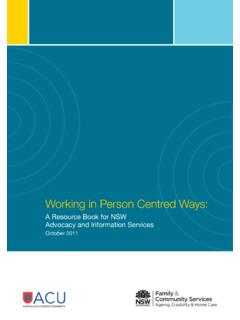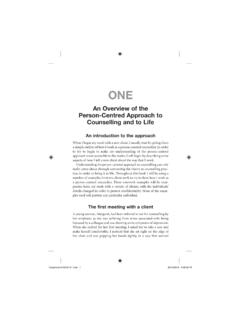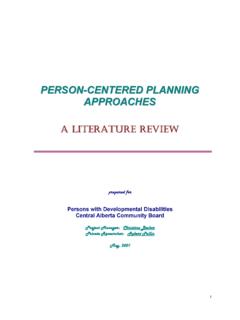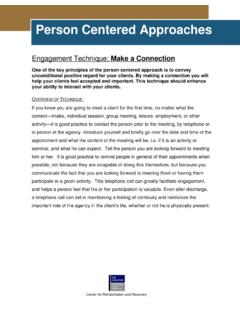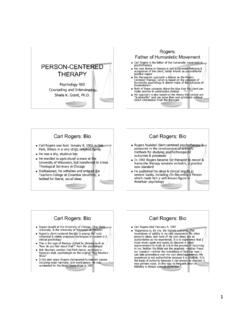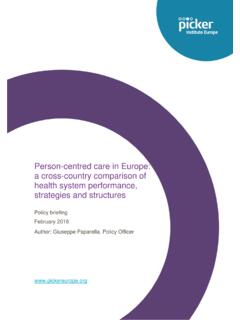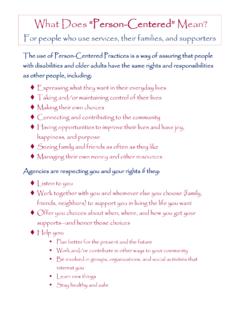Transcription of Working in Person Centred Ways - ADHC
1 Working in Person Centred ways : A Resource Book for NSW Advocacy and Information ServicesOctober 2011 Family & Community ServicesAgeing, Disability & Home CareJudith Ellis, Jane Sherwin and Trudy van Dam. Working in Person Centred ways : A Resource Book for NSW Advocacy and Information Services. Ageing, Disability and Home Care, Department of Family and Community publication was funded by Ageing, Disability and Home Care, Department of Family and Community Services. Ageing, Disability and Home Care & The Consortium for Person - Centred Approaches, as provided by the Copyright Act 1968, no part of this publication can be reproduced, stored in a retrieval system or transmitted in any form, or by any means without the express permission of the , Disability and Home CareDepartment of Family and Community ServicesLevel 5, 83 Clarence StSydney NSW 2000 Tel: 02 8270 AuthorsJudith Ellis has over 30 years experience in social advocacy, systems advocacy, leadership development and service development in England and Australia.
2 She was the director of a state wide advocacy agency for over 11 years and has worked in independent advocacy for most of her Working life. Judith is known across Australia for her work with families of people with developmental disability, for influencing the direction of policy, and for her organisational change Sherwin has been involved in the lives of people with disability since the late 1970s in a range of service roles and as an academic. Jane was Director of a Queensland capacity building service that was funded as an information service for 7 years. She works with groups and organisations on values-based quality, Person - Centred approaches and leadership development, services and van Dam is an academic Working in the area of inclusive education and disability studies at the Australian Catholic University.
3 She has 20 yearsw experience in service provision, ten as the CEO of a large service provider. Over that time she has been responsible for implementing sustainable Person - Centred approaches which have brought significant change to the lives of people with Why work in Person Centred ways ?What does it take?DefinitionsThe elements of a Person - Centred approach The needs of a Person Life in, and with, ordinary community My life, my say Positive beliefs and expectations Partnerships Planning and support Enabling structures and relationships578 IntroductionIn 2010/11 Ageing.
4 Disability and Home Care made a commitment that advocacy and information providers would have the opportunity to examine the implications of Person - Centred approaches for their commitment relates to the NSW Government s Stronger Together 2 reform of the disability service system, which will give people with a disability more control over their lives, including how the specialist disability system supports them. To progress reform, the NSW Government has allocated more than $141 million over the next five years for decision support resources, including information, planning, advocacy, case management and service brokers. This resource book was developed following a workshop in June 2011 for representatives of advocacy and information services in NSW.
5 In supplementing learning from the workshop, it is designed to:n promote a greater understanding of Person - Centred approaches by these servicesn assist them to examine their work with service providers n prompt reflection on the implications for their of the resource book is a step towards bringing people with a disability to the centre of decision-making about their lives today and in the future. This approach , which is has been internationally recognised, is particularly relevant for people from culturally and linguistically diverse backgrounds and those of Aboriginal and Torres Strait Islander , Disability and Home Care will be consulting extensively with people with a disability, their families, carers and service providers and other stakeholders about the implications of Person - Centred approaches for service delivery, including the changes needed to personalise work in Person Centred ways ?
6 Person Centred approaches help people get better lives. An advocacy service can advocate for this. An information service can inspire people to have this. Both advocacy and information services can influence disability and other services to work in Person - Centred Centred approaches can mean that people with disabilities have better lives. That means having:n a real homen a meaningful weekn purposen family, friends and acquaintancesn growth and self developmentn social groups to belong ton people treat you as an individualn control over the direction of one s life and futuren good healthn a belief systemn safety, security and justice4 n Working in Person Centred waysWhat does it take?
7 International literature 1 and the experience of practitioners, families and people with a disability indicates that significant and positive changes to the lives of people with a disability are more likely to come about when:n Specialist disability services are willing to review their own practices and focus on the future, not the past. They place more importance on offering beyond current practices and tailoring supports to meet the needs of individuals, instead of fitting the Person into what they have done in the There is strong leadership driving the service to change its values and the way it thinks about bringing individuals and families to the centre of decision making about their own lives and There is knowledge and information available about Person Centred approaches.
8 There is agreement that all parts of a service need to be involved in the changes to practice that result from implementing Person Centred approaches. This ensures that there is not just a superficial adoption of Person Centred approaches but provides everyone in the organisation with the skills needed to change the way they have traditionally responded to people with a There is a genuine partnership with people with a disability and families. The service encourages individuals and/or families to own their futures and goals and the service works to make sure that the Person s plans for their future are translated into There is a commitment to change the ways that funding is used, to seek different forms of funding that provide greater opportunity to implement Person Centred approaches, and to work to transform block funding into flexible individualised for NSW Advocacy and Information Services n 5 In order to support the kinds of community changes necessary to improve people s chances for a desirable future.
9 Virtually all existing human service policies and agencies will have to change the ways they regard people, the ways they relate to communities, the ways they spend money and the ways they define staff roles and responsibilities. 2 Advocacy and information services are crucial to ensuring that people with a disability can make life decisions which reflect their individual identities, interests and needs. This role involves direct advocacy with, and for, them at service provider and broader systemic levels. It also entails providing relevant and accessible information about the disability service system and about what is possible in their Ellis.
10 J., Sherwin, J., van Dam,T., (2008) Person Centred Planning: A review of the literature, Department of Ageing Disability & Home Care2 Valuing People A New Strategy for Learning Disability for the 21st Century Guidance for Implementation Groups term Person - Centred approach is best explained by looking at what it means for both people living with a disability and what it means for the organisations providing services to them and their approaches give people with a disability:n valued rolesn participation and belonging in the communityn freely given relationshipsn greater authority over decisions about the way they liven genuine partnership between the service, themselves and/or their family and alliesn individualised and personalised support approaches require that organisations.
